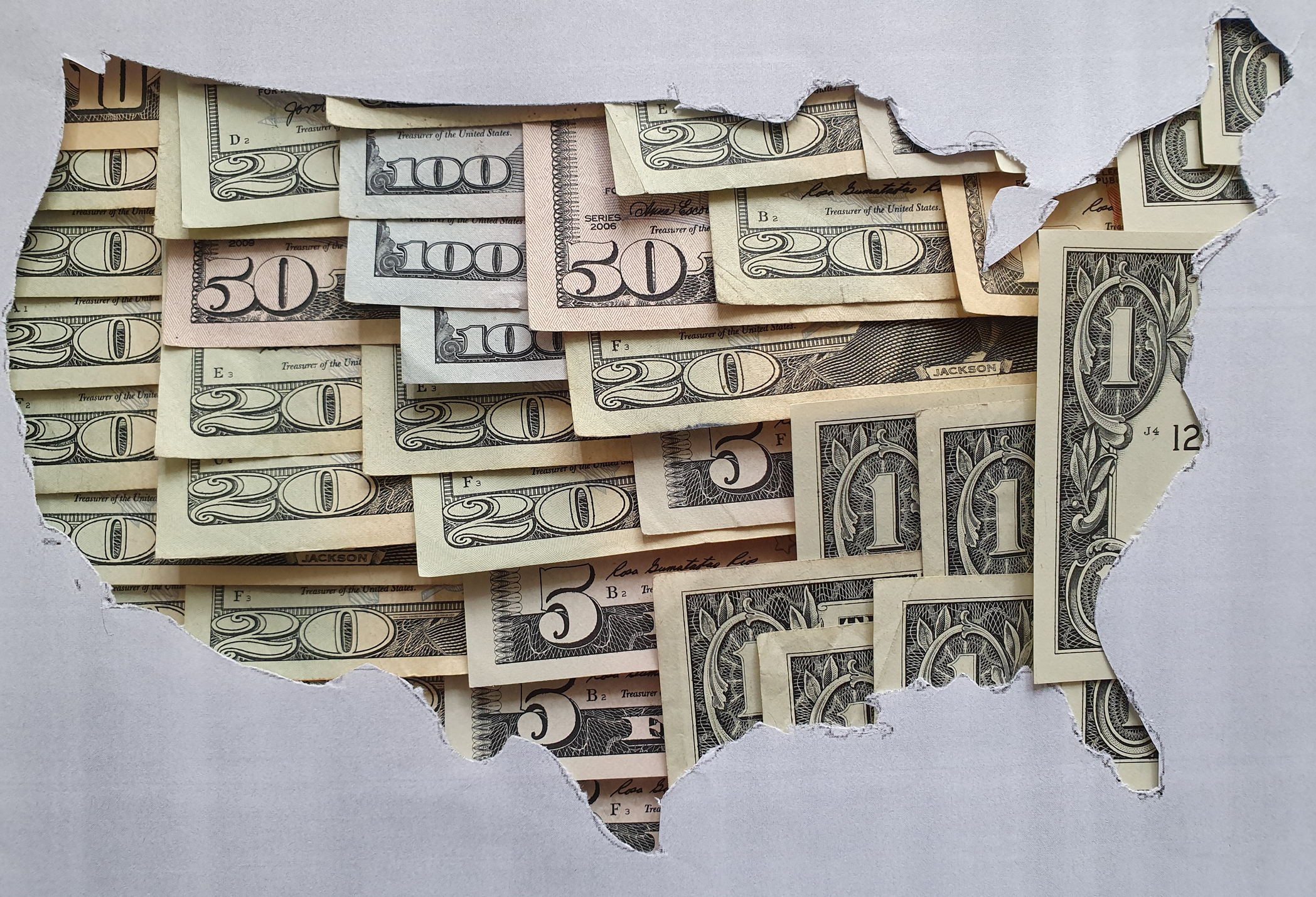What's the Recovery Rebate Credit?
If you didn't get a third stimulus check, or you didn't get the full amount, you may be able to claim the recovery rebate credit from your 2021 tax return to make up the difference.


Editor's note: This article was written in 2022. As of December 2024, the IRS is automatically sending recovery rebate payments to eligible taxpayers who filed 2021 returns. However, if you never filed your 2021 tax return, you have until April 15, 2025, to do so. For more information, see: The IRS is Sending Payments of up to $1,400 to One Million Taxpayers: Are You Eligible?
If you didn't get a third panedmic-era stimulus check back when the federal government was issuing them – or you only received a partial check – then you may want to check out the recovery rebate tax credit if you haven't yet filed your 2021 tax return.
The recovery rebate tax credit and stimulus checks are joined at the hip. In fact, third stimulus checks (including "plus-up" payments) were simply advance payments of the credit.

Sign up for Kiplinger’s Free E-Newsletters
Profit and prosper with the best of expert advice on investing, taxes, retirement, personal finance and more - straight to your e-mail.
Profit and prosper with the best of expert advice - straight to your e-mail.
So, if the combined total of your third stimulus check and any "plus-up" payment is less than your allowed recovery rebate credit amount, you may be able to get the difference back from your 2021 tax return in the form of a larger tax refund or a lower tax bill.
If your third stimulus check exceeded the amount of the credit, you don't have to repay the difference. Either way, you win!
This helps eligible Americans who either didn't receive a third stimulus check or didn't get the full amount. In some cases, even a person who received the $1,400 third-round payment can claim a recovery rebate credit that boosts their refund or reduces the tax they owe.
So, even if you weren't required to file a 2021 tax return, make sure you at least check to see if you qualify for the recovery rebate credit. If you do, go ahead and file just to claim the credit and get a refund. You have until April 15, 2025, to do so.
Eligibility for the Recovery Rebate Credit
The eligibility rules for the recovery rebate credit are basically the same as those for third-round stimulus checks. The big difference is that eligibility for the stimulus check was typically based on information found on your 2019 or 2020 tax return, while eligibility for the recovery rebate credit is based on information from your 2021 return. So, you could qualify for a stimulus check but not for the credit – and vice versa.
You're generally eligible to claim the recovery rebate credit if, in 2021, you:
- Were a U.S. citizen or U.S. resident alien;
- Can't be claimed as a dependent on another person's tax return; and
- Have a Social Security number (SSN) valid for employment that's issued before the due date of your 2021 tax return (including extensions).
- For married couples filing a joint return, if only one spouse has a valid SSN, you can only claim up to $1,400 for the spouse with a valid SSN.
- If you're claiming the extra $1,400 for a dependent, the dependent must also have a valid SSN or adoption taxpayer identification number (ATIN).
Generally, if neither you nor your spouse have a valid SSN, you can claim only up to $1,400 for each qualifying dependent claimed on your tax return.
However, if either you or your spouse was an active member of the U.S. Armed Forces at any time during 2021, only one of you needs to have a valid SSN to receive up to $2,800, plus up to $1,400 for each qualifying dependent.
A person who died in 2021 or 2022 can still claim the recovery rebate credit on their final tax return prepared by a surviving spouse or representative if the requirements listed above are satisfied.
How to Calculate the Recovery Rebate Credit
Similar to the eligibility rules, calculation of the 2021 recovery rebate credit is generally the same as the calculation of third-round stimulus checks, except that they're based on information from different sources.
Third stimulus checks were generally based on information from either your 2019 or 2020 tax return, whichever was most recently filed when the IRS began processing your payment.
If you didn't file a return for either of those two years, the IRS sent a third stimulus check based on whatever information was available. In many cases, that information comes from the Social Security Administration (SSA), Railroad Retirement Board, or Veterans Administration (VA) if you receive benefits from one of those federal agencies.
However, the amount of your recovery rebate credit is based entirely on information found on your 2021 tax return. (Don't include any information regarding your first- or second-round stimulus checks or the 2020 recovery rebate credit on your 2021 return!)
As with the stimulus checks, calculating the amount of your recovery rebate credit starts with a "base" amount.
For most people, the base amount for the 2021 credit is $1,400. The base amount for married couples filing a joint tax return is $2,800 (i.e., twice the general base amount). Then, you add on $1,400 for each dependent claimed on your 2021 return.
After adding up the base amount and any additional amount for your dependents, you then need to determine if your recovery rebate credit is reduced because of your income. Your credit will be reduced – possibly to zero – if you select the single, married filing separately, or a qualifying widow(er) filing status and have an adjusted gross income (AGI) above $75,000 on your 2021 tax return.
If you file a joint return with your spouse, your credit will start to shrink if your 2021 AGI is over $150,000.
For people who claim the head-of-household filing status, the tax credit is reduced if your AGI tops $112,500. Your credit completely disappears if your AGI is above $80,000 (singles), $120,000 (head-of-household), or $160,000 (joint filers).
Finally, after the credit is reduced (if necessary), you need to subtract the total third-round stimulus check and "plus-up" payments you received last year from the credit amount.
You report the final amount on Line 30 of your 2021 federal income tax return (Form 1040 or Form 1040-SR).
The recovery rebate credit is a "refundable" credit, meaning you'll get a tax refund if the credit is larger than the tax you would otherwise have to pay. ("Non-refundable" credits will only take your tax bill down to zero – they won't trigger a refund even if they're more than the amount you owe.)
There's a page-long worksheet in the instructions for Form 1040 that you can use to calculate the amount of your credit. Tax preparation software will run the numbers and calculate the credit.
Notice 1444-C, Letter 6475, and Online IRS Account
What if you forgot how much you received last year as a third stimulus check and/or "plus-up" payment? There are four ways to get that information.
First, the IRS should have sent you a notice after it sent your third stimulus check – Notice 1444-C. The IRS also sent separate notices to people who received a "plus-up" payment. You can find the proper amount to calculate the recovery rebate credit on these notices. If you received a joint payment with your spouse, the notice shows the total amount of payments. If you and your spouse file separate 2021 tax returns, each of you must enter half of the amount of the payment. Keep Notice 1444-C with your other tax records.
The IRS also sent another notice – Letter 6475 –with the same information earlier this year. If you received a joint stimulus payment with your spouse, Letter 6475 only shows half of the total payment amount, and each spouse could receive their letter at different times. If you and your spouse are filing a joint 2021 tax return, include both amounts when calculating the recovery rebate credit. If you're filing separate returns, each spouse should only include their half of the stimulus payment amount. As with Notice 1444-C, save Letter 6475 with your tax records.
You can also find the total amount to subtract from the credit on your IRS online account, if you have one. The amount of your third stimulus check is shown on the Tax Records tab under "Economic Impact Payment Information." If you and your spouse received joint payments, each of you will need to sign into your own account to retrieve your separate stimulus payment amounts.
Finally, you can request a 2021 account transcript. You can request online or by mail through the IRS's Get Transcript webpage. You can also call the IRS's automated phone transcript service at 800-908-9946 for it be sent by mail or submit Form 4506-T. If you received joint payments with your spouse, the transcript shows the total amount of each payment under the primary taxpayer. If you file separate 2021 tax returns, each of you must enter half of amount of the payment.
Lost, Stolen or Destroyed Third Stimulus Checks
If your third stimulus check was lost, stolen or destroyed, you can ask the IRS to do a "payment trace" to see if your check was cashed.
If you don't request a payment trace, expect the IRS to reject any recovery rebate credit claimed on your 2021 return. Since the payment was issued to you, the IRS will consider you ineligible for the credit.
If your third stimulus payment was sent on a debit card but you didn't activate the card before February 1, 2022, you should have received a letter from the IRS reminding you to activate your card or to request a replacement if you accidently threw the card away.
Who Will Actually Get a Recovery Rebate Credit?
Most Americans already received the full amount of the 2021 recovery rebate credit as a third stimulus check payment. For those people, subtracting the stimulus money they previously received will reduce their recovery rebate credit to zero. So, if you received a full third stimulus check, there's no need to complete the worksheet to calculate the credit.
However, certain groups of people could very well end up with a positive credit amount, which will result in a lower 2021 tax bill or larger tax refund. For example, assuming you're eligible, you may be able to claim a recovery rebate credit if:
- Your AGI was above the applicable phase-out threshold on your 2019 or 2020 tax return (whichever return was used to calculate your third stimulus check), but it's lower on your 2021 tax return;
- You added a dependent (e.g., had a new baby) in 2021;
- You share custody of your child, your ex-spouse claimed the child as a dependent for the 2020 tax year, and you claim the child as a dependent for 2021;
- You got married in 2021 (especially if there's a wide gap between each spouse's income);
- You could be claimed as a dependent on someone's 2019 or 2020 tax return (whichever return was used to calculate your third stimulus check), but not on anyone's 2021 return;
- You receive Social Security or veterans benefits, didn't file a 2019 or 2020 tax return, and care for a dependent child, but the IRS didn't get information about the child from the SSA or VA;
- You didn't have a SSN in 2021 but are issued one by the due date of your 2021 tax return (including requested extensions);
- The IRS sent you a third stimulus check that was less than what you were entitled to receive; or
- The IRS didn't send you a third-round stimulus check at all.
These are just a few of the more common reasons why you might be able to claim a recovery rebate credit. There will be other situations that result in a positive credit amount. That's why it's important that you run the numbers when you file your own 2021 tax return. If you're entitled to a refund, file your return electronically and sign up to have your refund directly deposited into your bank account to get your money the fastest.
(NOTE: If you reside in a U.S. territory, don't enter an amount on Line 30 of Form 1040 or Form 1040-SR. In general, the tax authorities in American Samoa, Guam, Puerto Rico, the U.S. Virgin Islands, and the Northern Mariana Islands will provide the recovery rebate credit to eligible residents.)
Avoid Mistakes That Will Delay Your Refund
Simply claiming the recovery rebate credit won't by itself delay the processing of your tax return or any tax refund. However, mistakes on your return – including mistakes calculating the recovery rebate credit – can slow things down and make you wait longer for your refund. Fortunately, though, you won't necessarily lose out on the credit if you make a mistake on Line 30 of your Form 1040.
The IRS won't calculate your recovery rebate credit or correct your entry if you enter $0 on Line 30 or leave it blank. The IRS will treat this as your decision not to claim the credit. However, if you make a mistake on the Line 30 amount ($1 or more), the IRS will calculate the correct amount of the credit, correct your tax return, and continue processing it.
The IRS won't contact you before making a correction, and you won't have to provide any additional information, but at least the IRS will send you a notice explaining any changes they make. This will also delay the processing of your return.
If you agree with the changes the IRS made, no response or action is required. If you disagree, call the IRS at the toll-free number listed on the top right corner of the notice.
Get Kiplinger Today newsletter — free
Profit and prosper with the best of Kiplinger's advice on investing, taxes, retirement, personal finance and much more. Delivered daily. Enter your email in the box and click Sign Me Up.
Rocky Mengle was a Senior Tax Editor for Kiplinger from October 2018 to January 2023 with more than 20 years of experience covering federal and state tax developments. Before coming to Kiplinger, Rocky worked for Wolters Kluwer Tax & Accounting, and Kleinrock Publishing, where he provided breaking news and guidance for CPAs, tax attorneys, and other tax professionals. He has also been quoted as an expert by USA Today, Forbes, U.S. News & World Report, Reuters, Accounting Today, and other media outlets. Rocky holds a law degree from the University of Connecticut and a B.A. in History from Salisbury University.
-
 Financial Security vs Financial Freedom: What's the Difference?
Financial Security vs Financial Freedom: What's the Difference?Having the ability to pivot without worrying about financial support is where financial security becomes financial freedom.
By Justin Donald Published
-
 Retired and Worried About a Recession? Six Ways to Prepare
Retired and Worried About a Recession? Six Ways to PrepareRetirees can plan for a near-term recession with a range of strategies, from small investment changes to significant lifestyle hacks.
By Maurie Backman Published
-
 Did Florida’s Chance at $1,000 in Property Tax Rebates Vanish?
Did Florida’s Chance at $1,000 in Property Tax Rebates Vanish?State Taxes The Florida Legislature bypassed Gov. Ron DeSantis’ wish to cut property taxes and instead voted to lower the state’s sales tax.
By Gabriella Cruz-Martínez Published
-
 How Caregivers for Adults Can Save on Taxes in 2025
How Caregivers for Adults Can Save on Taxes in 2025Tax Breaks Caring for your parent or spouse can be stressful, but the IRS offers tax breaks for qualifying taxpayers. Here they are.
By Kate Schubel Published
-
 New South Carolina Income Tax Cut Might Eat Your Cash
New South Carolina Income Tax Cut Might Eat Your CashState Taxes South Carolina’s flat income tax bill could have the majority of residents paying higher income taxes. Find out how.
By Kate Schubel Published
-
 U.S. Treasury to Eliminate Paper Checks: What It Means for Tax Refunds, Social Security
U.S. Treasury to Eliminate Paper Checks: What It Means for Tax Refunds, Social SecurityTreasury President Trump signed an executive order forcing the federal government to phase out paper check disbursements by the fall.
By Gabriella Cruz-Martínez Published
-
 IRS Layoffs Spark Delays, Doubt This Tax Season
IRS Layoffs Spark Delays, Doubt This Tax SeasonTax Season Tax experts say Trump’s downsizing of the IRS is already causing problems.
By Gabriella Cruz-Martínez Last updated
-
 States with the Highest Income Tax Rates for Retirees
States with the Highest Income Tax Rates for RetireesState Tax You may reconsider living and retiring in one of these states due to high taxes.
By Kate Schubel Last updated
-
 AI Tax Scams Target Middle and Older Adults: What to Know
AI Tax Scams Target Middle and Older Adults: What to KnowScams Whether you’re a retiree or Gen Z, scammers can gouge big financial losses with the help of artificial intelligence.
By Kate Schubel Published
-
 Tax-Deductible Home Improvements for Retirement in 2025
Tax-Deductible Home Improvements for Retirement in 2025Retirement Taxes Your aging-in-place plan could benefit from the medical expense tax deduction. But watch out for capital gains and property taxes.
By Kate Schubel Published